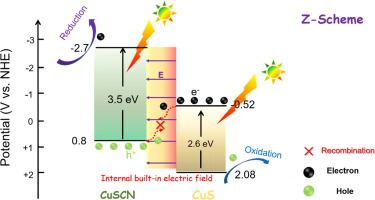Journal of Colloid and Interface Science ( IF 9.4 ) Pub Date : 2021-02-02 , DOI: 10.1016/j.jcis.2020.12.126
Pei Ning , Junhui Liang , Linghui Li , Da Chen , Laishun Qin , Xin Yao , Huayu Chen , Yuexiang Huang

|
Copper thiocyanate (CuSCN) has been considered as a promising hole transport material (HTMs), attributing to its inherent stability, low-cost, and suitable energy levels. To make it more attractive in practical applications, the drawbacks of CuSCN in poor charge transport and serious defect recombination are bottlenecks that need to be overcome. In this work, we propose an effective strategy of in-situ decorating CuSCN with copper sulfide quantum dots (CuS QDs), a simple one-step electrochemical deposition process, to solve these issues. Compared with the pristine CuSCN, the constructed Z-Scheme heterojunction of CuS QDs/CuSCN can significantly promote charge transport and restrict recombination. In addition, the decorated CuS QDs can not only passivate defects of CuSCN, but also provide more contacting sites to facilitate hole injection when employing as HTM. As a result, the average bulk charge lifetime was improved from 0.37 ms to 0.47 ms, and the surface recombination rate constant was suppressed. We believe that the excellent performances will pave it toward practical device applications, including solar cells, photocatalysis, photoelectrochemical sensors, and light-emitting diodes.
中文翻译:

Z型CuS / CuSCN异质结的原位生长可钝化表面缺陷并增强电荷传输
硫氰酸铜(CuSCN)被认为是一种有前途的空穴传输材料(HTM),这归因于其固有的稳定性,低成本和适当的能级。为了使它在实际应用中更具吸引力,需要克服的瓶颈是CuSCN的电荷传输不良和严重的缺陷复合。在这项工作中,我们提出了一种有效的策略,即用一个简单的一步式电化学沉积工艺用硫化铜量子点(CuS QDs)原位装饰CuSCN。与原始的CuSCN相比,构建的CuS QDs / CuSCN的Z型异质结可以显着促进电荷传输并限制重组。此外,经过修饰的CuS QD不仅可以钝化CuSCN的缺陷,而且在用作HTM时,还提供了更多的接触部位以促进空穴注入。结果,平均体电荷寿命从0.37ms提高到0.47ms,并且表面复合率常数被抑制。我们相信,出色的性能将其应用于实际的设备应用,包括太阳能电池,光催化,光电化学传感器和发光二极管。

































 京公网安备 11010802027423号
京公网安备 11010802027423号